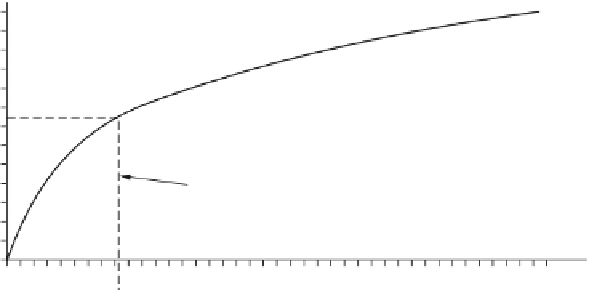Geoscience Reference
In-Depth Information
94
92
90
88
86
2-yr Required storage from
graphical hydrograph analysis = 0.82 ac.ft.
84
82
81
0
1.0
0.82
2.0
3.0
4.0
Storage (ac/ft.)
FIGURE 25.19
Stage-storage curve.
5. Sum the volume for each contour interval in column 7. Using Figure 25.18, this is simply
the sum of the volumes computed in the previous step:
Contour 81 volume = 0
Contour 82 volume = 0 + 900 = 900 ft
3
Contour 84 volume = 900 + 5040 = 5940 ft
3
Contour 86 volume = 5940 + 8414 = 14,354 ft
3
Column 8 allows for the volume to be tabulated in units of acre-feet: ft
3
+ 43,560 ft
2
/ac.
This procedure is then repeated for each measured contour interval.
6. Plot the stage-storage curve with stage
on the
y
-axis vs. storage on the
x
-axis. Figure 25.19
represents the stage-storage curve for our example in units of feet (stage) vs. acre-feet
(storage).
The stage-storage curve allows the engineer to estimate the design high water elevation for each
of the design storms if the required storage volume has been determined. This allows for a prelimi-
nary design of the riser orifice sizes and their configuration.
25.7.9 W
ater
q
uality
and
C
hannel
e
rosion
C
ontrol
v
olume
C
alCulations
Va r ious local stormwater management regulations (the reader is advised to check with their local
requirements) require that the first flush of runoff, or the water quality volume, be treated to enhance
water quality. The water quality volume (
V
wq
) is the first 0.5 inches of runoff from the impervious
area of development. The water quality volume must be treated using one or a combination of best
management practices (BMPs) depending on the total size of the contributing watershed, amount of
impervious area, and site conditions.
Calculate the water quality volume:
V
wq
= Impervious area (ft
2
) × (1/2 in.)/(12 in./ft)
(25.10)
V
wq
(ac-ft) = V
wq
(ft
3
)/43,560 ft
2
/ac
(25.11)
The water quality volume for a wet BMP may be dependent on the specific design criteria for that
BMP based on the watershed's imperviousness or the desired pollutant removal efficiency (using
performance-based or technology-based criteria, respectively). This discussion is focused on the
calculations associated with the control of the water quality volume in extended detention and reten-
tion basins.

Search WWH ::

Custom Search